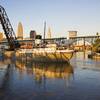The National Transportation Safety Board (NTSB) has updated information on its investigation of the boiler explosion aboard the Norwegian Cruise Line vessel NORWAY while moored in Port of Miami in Miami, Fla. They have confirmed that 2,135 passengers and 911 crew aboard the vessel. The explosion killed 7 crewmembers and injured over a dozen others. All passengers were evacuated safely. The NTSB investigation into the boiler room explosion on board the Bahamian cruise ship Norway continues in the data collection phase, but investigators have completed nearly 200 personal interviews with ship's officers, crewmen and company officials. The interviews with the ship's engineering officers indicate that they had not observed anything out of the ordinary in the boiler room or in the operating console before the event.
At the time of the explosion, three of the Norway's four main propulsion boilers were in normal-in-port operating status supplying steam to electrical generators and auxiliary equipment while the ship was moored to the dock in Miami. Boiler no. 21, located in the forward starboard side of the boiler room, was secured and was not in operation at the time. Boiler no. 23, located aft of boiler no. 21, was the boiler involved in the explosion. No maintenance was being carried out on boiler 23 at the time of the explosion.
NTSB investigators are closely examining boiler no. 23 to determine why it exploded. The investigation has progressed slowly because of the extreme safety and health conditions in the damaged boiler room. Investigators have had to don personal protective equipment, including respirators because of the high level of asbestos. Asbestos was used to insulate the steam piping throughout the boiler room. The area is not well ventilated and is poorly lighted. The force of the explosion has ripped away walkways, making access difficult. Because of the heat, poor ventilation, and the necessity to wear protective equipment, investigators are limited to about one hour in the space at one time, after which they must go through a decontamination process.
Damages to boiler no. 23 were extensive. The outer casing is ruptured allowing the interior of the boiler to be visible on the starboard aft section. The explosion knocked out and opened doors three decks above the boiler. Fuel oil heaters on the starboard side of the boiler were blown partially from their mounting brackets and were found to be hanging loose.
Investigators have examined a water wall header that was found to have significant material failure. The header is one of three separate drums of the boiler that runs the length of the boiler. The header is a component of the system that facilitates in the circulation of the boiler steam-water cycle.
The Norway has four boilers, constructed by Chantiers de l' Atlantique, Penhoet-Loire, France. The dimension of each boiler is about 30 feet high by 25 feet-across the front, by 20 feet on the sides. The operating pressure of each boiler is about 900 psi, supplying superheated steam used for vessel propulsion. Boiler no. 23 underwent a complete boiler survey in July 2002, by a class surveyor from Bureau Veritas. This survey is performed about every 2 years.
In the areas adjacent to the boiler room on the starboard sides of Decks 4 and 5, there was significant physical damage to bulkheads, doors and doorframes. Crew cabins on the Caribbean deck sustained severe damage to the inboard (passageway) bulkheads, door and doorframes. The cabin doors were blown out of the frames, damaging the frames in the process. Debris from the boiler room was deposited on exposed surfaces.
There were doors on B deck that were blown off their frames. One inboard bulkhead on B deck had been knocked down completely. All exposed surface areas had been covered with the same soot mixture found in the passageways.
Marine boiler experts from the Military Sealift Command and an automation specialist from the Naval Sea Systems Command have augmented the NTSB investigation. In addition, a metallurgist from the NTSB Laboratory in Washington, D.C. is on scene to perform metallurgical examination of the boiler. Investigators are examining every part of the boiler to determine what happened. In addition, they are examining boiler automation and safety systems, boiler maintenance records, survey reports, and logbook entries to ascertain the condition of the boiler before the explosion.
NCL is canceling the ship's sailings through the September 28, 2003 cruise. NCL says they are fully cooperating with the National Transportation Safety Board and United States Coast Guard to understand the cause of the boiler room accident.
NCL has stated that access to the boiler room has been limited, but the assessment of the damage contends that it is extensive but manageable. The boiler involved in the accident will be completely rebuilt, as well as with other technical spaces, automation systems and equipment damaged in the blast.
Although a detailed work specification has yet to be finalized, the repair work is likely to take months rather than weeks. Due to the extent of repairs, NCL has cancelled three months of cruises in addition to the already announced June cancellations. NCL intends to reintroduce the ship on October 5, 2003.
NCL is pleased to report that two more crewmembers have been released from the hospital - Ronnie Melicio, 26, and Odeniel Manaman, 34, both of the Philippines and members of the ship's engine department. The company has provided the crewmembers with rooms at local hotels near the hospital so they can receive further treatment as needed. Four crewmembers remain hospitalized, three in stable condition and one in critical condition.
Featured videos

Inmarsat Enhances Service to Drive Digitalization

Unlock Onboard Data Efficiencies

Tracking Foreign Vessels Working in the U.S. Jones Act Market
Subscribe for
Maritime Reporter E-News
Maritime Reporter E-News is the maritime industry's largest circulation and most authoritative ENews Service, delivered to your Email five times per week








